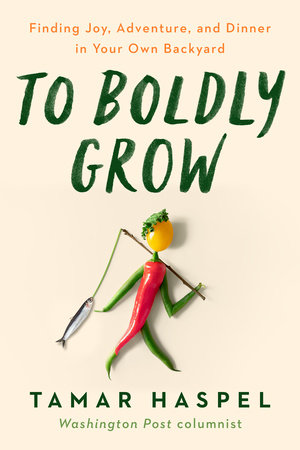Chapter 1We Begin UnsoiledLet me introduce you to our house.
When we were shopping for it, we told our real estate agent we were looking for a small house on one of Cape Cod's many ponds-a shack on a lake, basically.
Most of the shacks built on Cape Cod waterfront property have been torn down and replaced with much more majestic homes, but ours somehow slipped through the cracks. It was built in the early fifties and measures some 900 square feet. It was very shack-like.
I don't think I realized quite how shack-like until our first winter. After the first snowstorm of that first winter, I was at the top of our driveway shoveling the pile of snow the plow had deposited, and met for the first time our neighbor across the street, who was doing the same thing. We introduced ourselves and chatted for a bit, and she mentioned that despite having lived there for fifteen years, she had never seen our house. I of course invited her over, and we walked together down our very long driveway. It took a couple of minutes; you can't see the house until the driveway bends to the left at the bottom of the hill.
She knew it was on the water, and she was clearly expecting the usual majesty. When we rounded the bend, I watched as her face did that cartoon thing when a smile of anticipation morphs into a little grimace of disappointment. Since then, people's reactions to our house have become a running joke between Kevin and me. When they see it for the first time, almost everybody-literally almost everybody-looks around and says, "Nice . . . um . . . nice . . .
spot," clearly relieved to have settled on the right word.
It is a nice spot. It has privacy and giant rhododendrons and a view of the sunset over the water. The house is much closer to the water than current regulations allow. The lake is clear and cold and deep. So when we first saw the hills and the trees that cover nearly all of the property in dappled shade for most of the summer, we didn't think, Well, that's not so great for gardening. We thought, Nice spot.
It was only after we'd moved in and started thinking tomatoes that the shortcomings of our property came home to us. And it wasn't just the hills and the trees. It was also the soil; even I could see it didn't look good. In fact, it didn't look much like soil at all. It looked a lot like sand. And the plants that seemed to be thriving were the same ones you see all over Cape Cod: scrub oak, pine, and various kinds of grasses that can scrape by on limited nutrition and prefer fast-draining soil that keeps their roots dry.
The U.S. Department of Agriculture (USDA) confirmed my suspicions, and if you have suspicions about your own soil, they can confirm those, too. They do that with what I think is a remarkable database: the Web Soil Survey. Starting in 1899, the government has been sending soil surveyors out to every corner of our very large country so that we, the gardeners, can know exactly what's in our backyard. Now, 120-odd years in, they've covered nearly 95 percent of U.S. counties, so the chances are good that you can check yours right now. When I first found this out of course I fired up the computer immediately, with feelings of foreboding.
And sure enough, this was my soil profile:
0-7 inches: Carver coarse sand
7-17 inches: Carver coarse sand
17-64 inches: Carver coarse sand
And then it added, "Ha-ha!"
Okay, not that last part, because the government is circumspect about laughing at the agronomical plight of taxpayers. But I can read between the lines.
If you check out the literature on growing vegetables in sand, you will find nothing but pessimism. But I knew that other people on Cape Cod managed to have gardens. Could their soil be that much different? One of the first things we did when we arrived here was join the Cape Cod Organic Gardeners (annual dues: $5), in the hope of tapping into the local expertise. And two of the first people we met were Al and Christl, a couple about our parents' age who have the best garden I've ever seen. On the south-facing side of their house is the spot they call "the riviera," home to tomatoes that produce all summer. Farther down their backyard there are the biggest rhubarb plants east of the Mississippi. And then there's the asparagus.
Al and Christl's asparagus patch has been there for a couple of decades, and it's the purple kind. The first time they gave us some, I was skeptical. The stalks were a good inch in diameter, and I figured they had to be stringy and tough. But seriously, do you really think the best gardeners you know would give you stringy, tough asparagus? It was wonderful and tender and flavorful. And as a bonus, the purple kind doesn't make your pee smell.
Could their success be in their soil?
I hopped back on the Web Soil Survey and typed in their address. I felt like a voyeur doing this, as though if I zoomed in far enough I'd catch them cavorting in the gazebo, so I quickly got the information I needed and zoomed out again.
It turned out that Al and Christl built their garden on something called Hinesburg sandy loam. Loam is, and I'm quoting the Soil Survey here, "a mix of the small particles that form clay, the large particles that form sand, and the medium-size particles that form silt." Okay, that's better than flat-out coarse sand, but nowhere in that description were words like fruitful or fecund. There were still lots of teeny rocks.
If Al and Christl could grow rhubarb plants the size of a Volkswagen and enough tomatoes to get them through the winter in Hinesburg sandy loam, surely, perhaps with some compost and fertilizer, and maybe a little advice from Al and Christl, we could coax enough vegetables out of Carver coarse sand to keep our first-hand food commitment going.
Just SowThere's no denying that seeds are miracles. You start with this little tiny roundish thing, add water and sunlight, and get food! At least some of the time.
Seed season takes its time coming to Cape Cod because the water we're surrounded by is quite cold in March and April, and it keeps temperatures depressingly low through what is known as spring in other parts of the northern hemisphere. The joke is that our calendar reads: January, February, March, March, March, June. (The flip side is a spectacular fall; September is the best month to visit, but it's a secret, so don't tell anyone I told you.)
This means that even though you invariably start thinking about gardening in the first March, you can't really do much about it until the third-unless you can give your seeds a head start.
We almost didn't go to the Cape Cod Organic Gardeners' seed-starting workshop. I mean, really, you put the seed in the little pot and give it water and sunlight. It's the stuff of kindergarten projects. But we figured there might be agricultural techniques that weren't covered in kindergarten, so on a brisk second-March Sunday we headed out to Kelly Farm. Its owner, Jean Iverson, who stands a formidable (I am not kidding) four-ten and was then in her eighties, grew way more vegetables than you could imagine a third of an acre could produce. And she could still push the big Gravely rototiller, and no thank you, she didn't need your help.
There were about fifteen of us, and Jean walked us through the process of starting our own seeds. First, you have to use a soil mix specifically designed for the purpose (mostly, that means it has to retain water; seeds don't need fertilizer to germinate since they have their first helping of food built right in). You have to keep them moist but not wet. They have to be in a warm, dark place (indoors) until they sprout, and then moved into the light (outdoors), but still kept warm. We learned to be ruthless in our culling. And we learned about cold frames.
Now, a heat lamp keeps things hot. An icebox keeps things cold. So imagine my surprise on finding out that a cold frame keeps things . . . warm. It's basically a little greenhouse that gives your seedlings, still in their seed-starter soil mix, just enough passive solar to get them through to the third March (that's May, in case you've lost count), when it's probably safe to put them in the ground.
All that was standing between us and our first real vegetable garden was a wooden frame with a glass top, which seemed within our capabilities to build.
By our capabilities, I of course mean Kevin's capabilities. When I found him, he already had extensive experience with power tools. I, on the other hand, had gone my entire life up to that point without ever having used one. Building what was essentially a box seemed like it would be a good introduction.
Frame UpWhen I lived in San Francisco, back in the eighties, the department of sanitation designated one day a year when they would pick up absolutely anything you left at the curb. I had a group of friends who treated it like a national holiday-Big Trash Day-and we'd go out to see what we could find.
But scavenging seems to be a practice that some people are good at and some people aren't. Although I enjoyed the exercise, I never found anything truly remarkable. My mother, though, knew a woman in New York who found a museum-quality antique bed in the trash. My little brother Jake once found a brand-new wet suit-in his size-in a tony part of the West Village.
If you are building a cold frame, I guarantee you could find everything you needed on Big Trash Day. But we don't have that here on Cape Cod. This is unfortunate, in part because we're always doing things like building cold frames.
Luckily, we have the dump.
I know, I know! You're not supposed to call it the dump. It's the "transfer station," an obvious name for the place you go to dump things. And that is what you're supposed to do; there are in fact rules against taking things away from our local transfer station. In general, Kevin and I are law-abiding citizens, but putting things other people are throwing away to good use seems like a pretty good reason to flout the rules.
Besides, if we take stuff away, it really is a transfer station. We're just here to lend credibility to the nomenclature.
You do, however, have to avoid the dump workers (refuseniks, in family parlance), who sometimes, reluctantly it seems to me, enforce the no-taking-away rule. But discarded windows and doors-which are calling out to be the top of a cold frame-are in the metal pile, and if you back your truck up and create a diversion by discarding some actual metal, you can sometimes sneak out a storm door without calling attention to yourself.
Once you have that, you just need a frame. We planned to make ours out of wood, which meant a trip to the lumberyard. Our first choice of building material was cedar, since it's bug- and rot-resistant. It also ran $5 per board foot, which would have brought our costs for our cold frame up to the $150 range. That was way outside our budget, which was $0 when we began, but which we upped when we realized we'd have to buy framing material. Luckily, treated lumber, which is pine soaked in chemicals to make it bug- and rot-resistant, is much cheaper.
We had heard, as you probably have, that you shouldn't use treated lumber for plant-related enterprises because of those chemicals. So I was delighted to fall back on the one thing that I am actually pretty good at: research. And I am here to tell you that you don't have to worry about it. Back in the day, one of the chemicals used to treat lumber was arsenic, but that was phased out a good ten years ago. The rest of those chemicals might even help ward off pests and fungi (that is, after all, their reason for being there), but not very much because they don't travel far in soil. And no appreciable amount of them will end up in your food.
Treated lumber it was: 18s for the sides and 44 uprights for the corners. Literally all that had to happen was to screw the 18s into the 44s, and you're two hinges away from a cold frame.
That, at least, was Kevin's perspective. Mine was that this seemed waaaaay harder than, say, hanging a picture, and maybe we should take a rest and think about it for a while. But it's amazing the difference a little confidence, coupled with an 18-volt cordless DeWalt drill, makes. The ease and speed with which the cold frame came together surprised me. Hanging a picture would have taken me three times as long, with at least twice the angst.
If you're hankering for a cold frame but don't have easy access to cast-off storm doors (or power tools, or Kevin), there is a super-quick and easy option, which I'm sorry to report that we discovered only after we built the storm-door version and figured out we needed an annex to accommodate our rather optimistic spread of seed starts.
This is where I'd try to explain how Kevin's mind works, if I had even the foggiest of clues. But after twenty years with him, I have no idea. No matter what the project is, we tackle it in completely different ways. If there are ten ways to do something, and you ask each of us to list our top five, there will be no overlap.
And so it was, we were in Home Depot, thinking about our need for more cold-frame space. I almost literally saw the lightbulb go on over his head, and he grinned and walked me over to the vents and insulation section. We didn't need vents or insulation, so I had no idea where he was going with this.
He went straight to the window covers-those half domes of heavy plastic that people put over ground-level window wells-and took two off the shelf. Then he took me two aisles over, to the clamp section, and picked up a half-dozen smallish ones. He put the window covers on the floor, back to back, and clamped the seam shut. Voilà! Instant circular cold frame.
I would not have thought of that in a million years, but since he did, you and I don’t have to. For under $40, you can build a cold frame in seven seconds. Thank Kevin if you see him.
While I was marveling at my husband’s ingenuity, our seeds were busy germinating, and we had our cold frames ready just in time to put our little proto-plants outdoors.
That’s when the trouble started.
At least I thought that's where the trouble started. I learned later that the trouble started with the
decisions I’d made about the seeds in the first place.
"Oh, no! You can't start delicate plants like cucumbers this early," Christl said, when I told her, in consternation, that every single one of my cucumber seedlings had died just days after we put them in the cold frame. She also explained, as diplomatically as a kind human can, when faced with a friend’s boneheaded mistake, that you can’t start root vegetables that way at all; those seeds go right in the ground. The fennel didn’t even have a decent excuse; in the absence of any obvious error, they were irredeemably thin and leggy, the Gisele Bundchens of seedlings. The cold frame was also pervaded by a general air of dispiritedness, which I'm convinced is contagious.
It was a combination of the wrong plants, the wrong time, and I’m pretty sure just the wrong mojo. A few of our seed-starts managed to limp into the garden, but mostly we fell back on the tried-and-true gardening strategy of half-assed gardeners everywhere: we bought a bunch of seedlings, ready to plant. Let’s let someone else do this seed-starting job, shall we?
The pickings were slim, but we found a couple of relatively level, sunny spots on our hilly, shaded property to be our actual garden. Then we pulled up all the chickweed, which is about the only thing we can grow in exuberant abundance. (And chickweed isn’t like chick lit or chick flicks – there’s nothing frothy or ephemeral about it. Chickweed is a formidable adversary). Once we removed it, we amended our Carver Coarse Sand with standard-issue all-purpose fertilizer, some amendments a soil test had told us we needed, and what I believe qualifies as a shit-ton of compost.
Along the way, we made a mistake that I want to make sure you, the first-time gardener, don’t make. Do not, under any circumstances, buy a wheelbarrow.
Copyright © 2022 by Tamar Haspel. All rights reserved. No part of this excerpt may be reproduced or reprinted without permission in writing from the publisher.







